
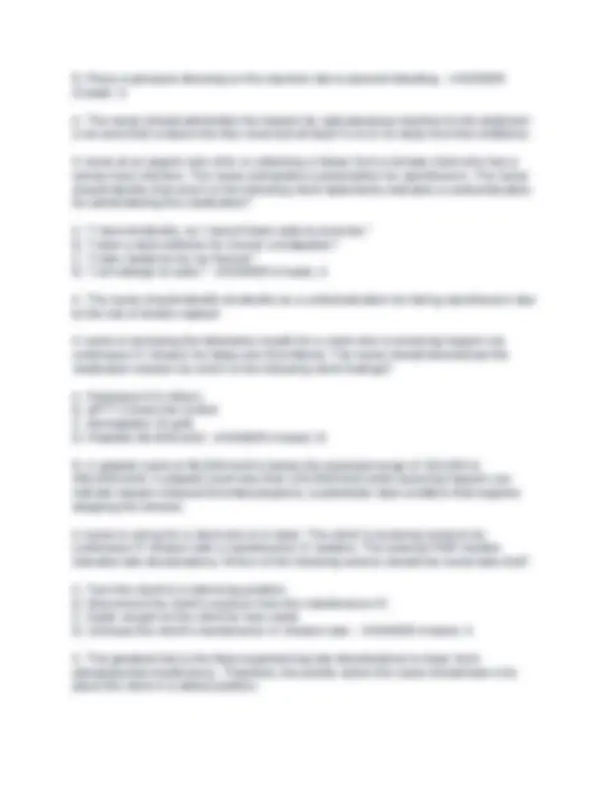
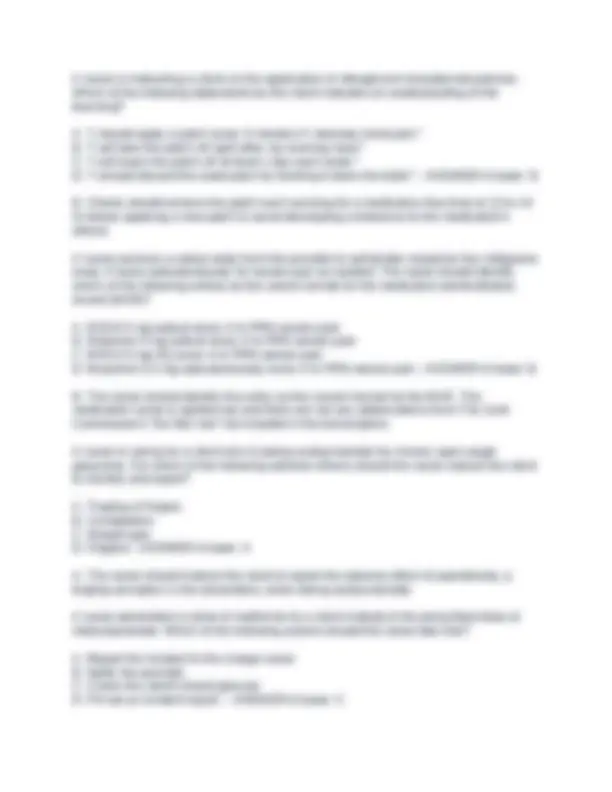
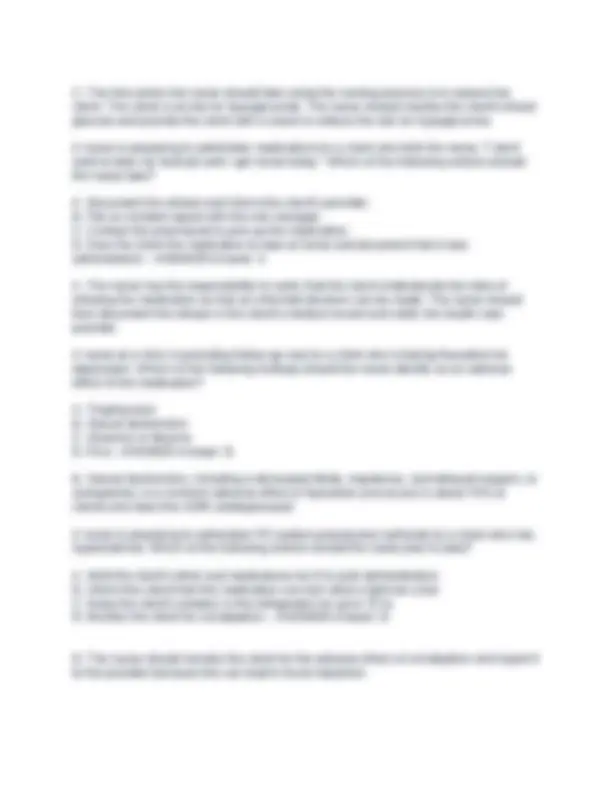
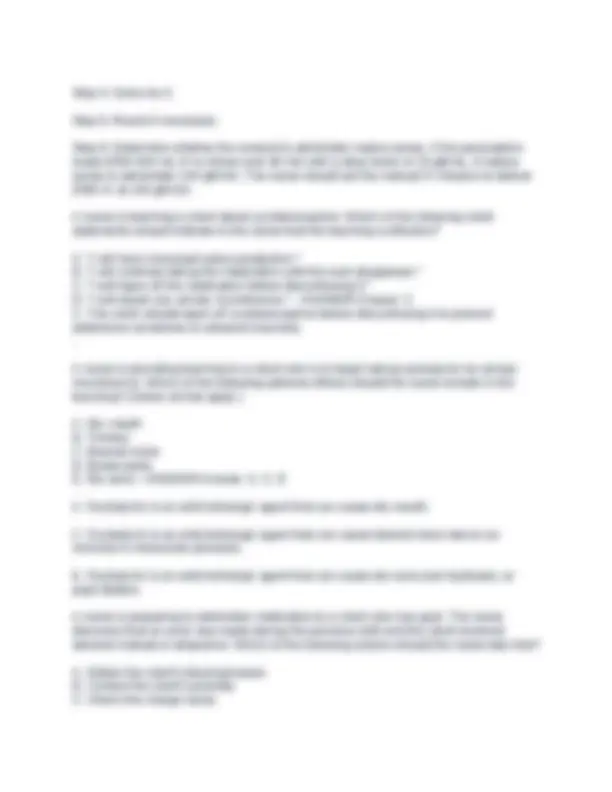
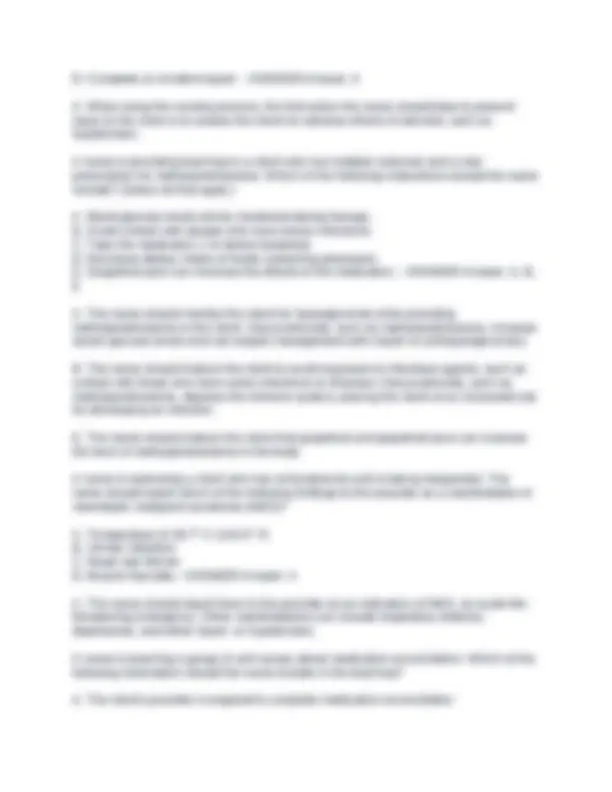
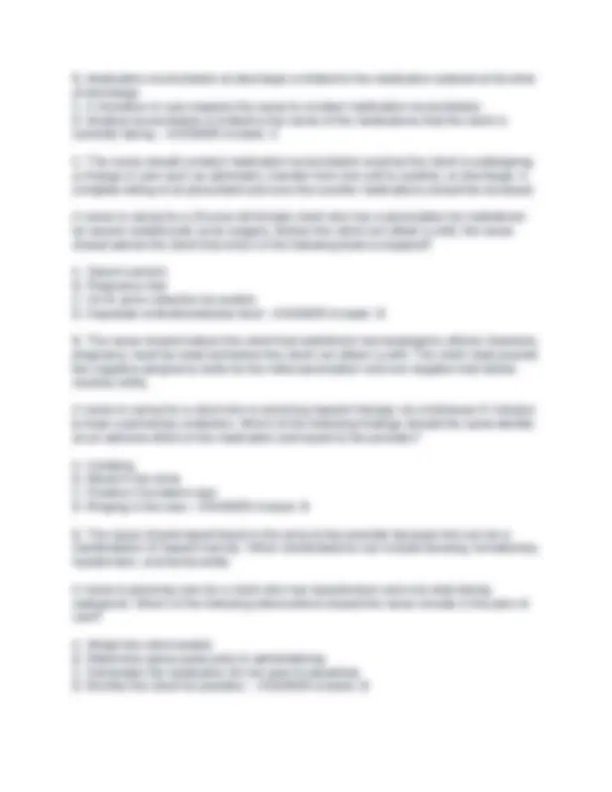
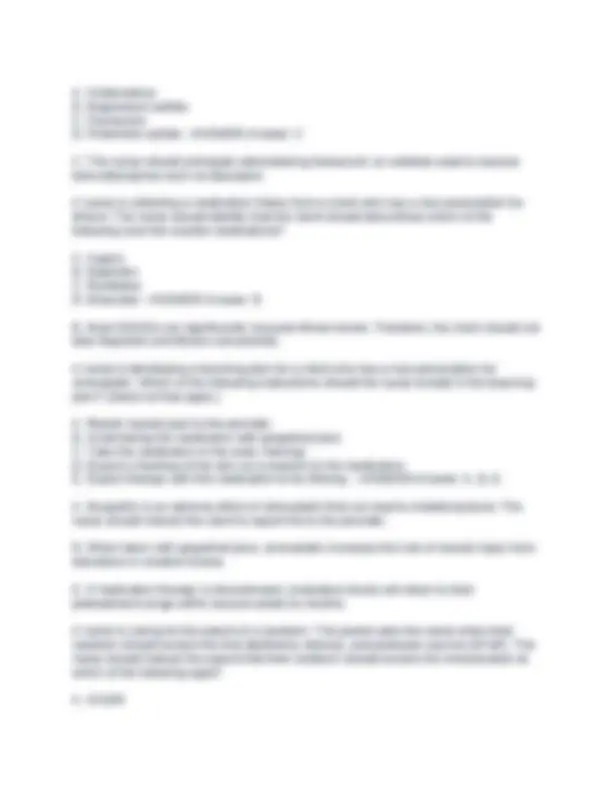
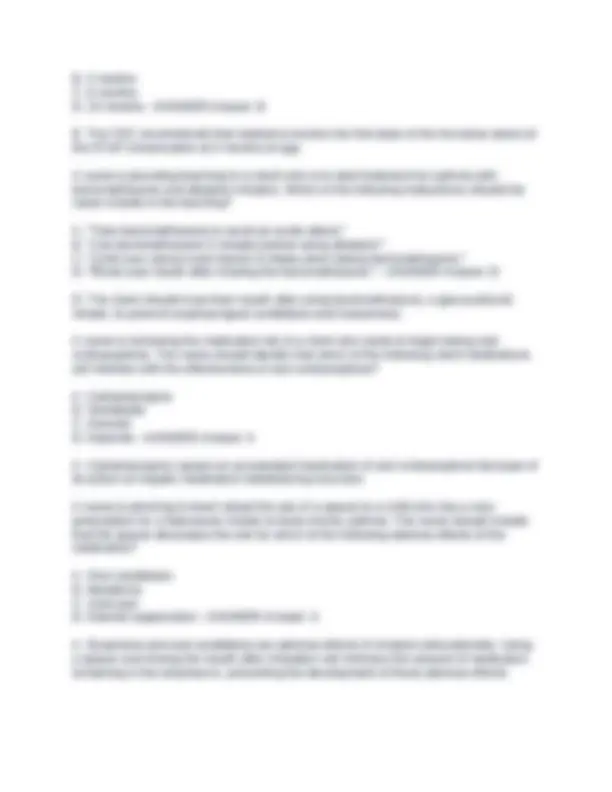
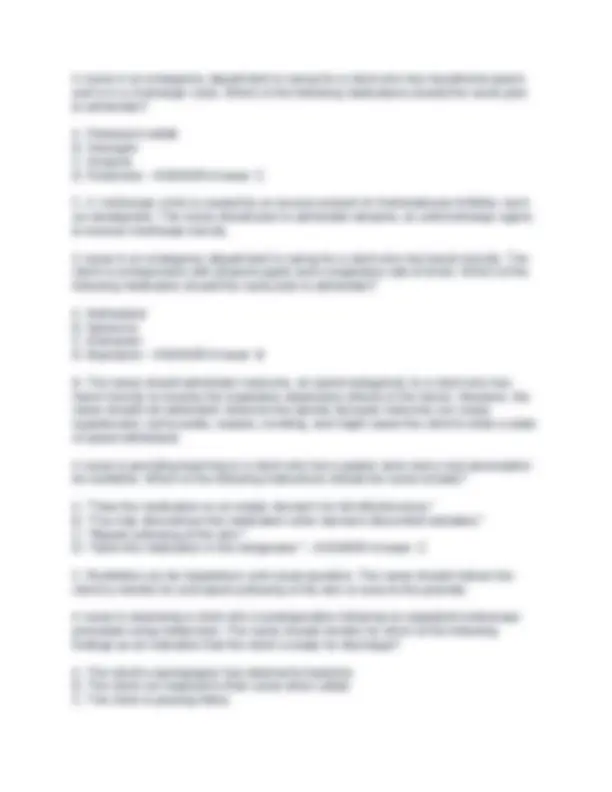
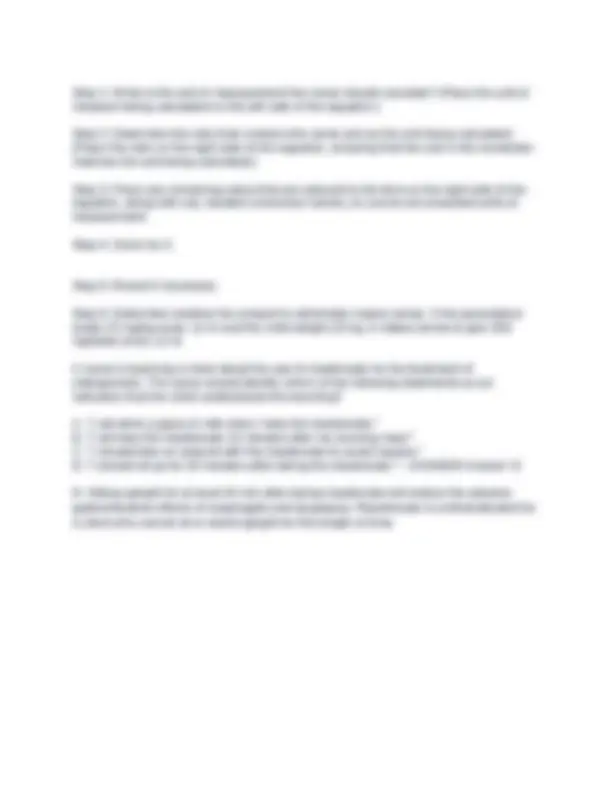


Study with the several resources on Docsity

Earn points by helping other students or get them with a premium plan


Prepare for your exams
Study with the several resources on Docsity

Earn points to download
Earn points by helping other students or get them with a premium plan
Community
Ask the community for help and clear up your study doubts
Discover the best universities in your country according to Docsity users
Free resources
Download our free guides on studying techniques, anxiety management strategies, and thesis advice from Docsity tutors
A nurse is caring for a client who has cancer and is taking oral morphine and docusate sodium. The nurse should instruct the client that taking the docusate sodium daily can minimize which of the following adverse effects of morphine? A. Constipation B. Drowsiness C. Facial flushing D. Itching - ANSWER-Answer: A A. Constipation is a common adverse effect of morphine that can be minimized by taking docusate sodium, a stool softener that promotes easier evacuation of stool by increasing water and fat in the intestine. A nurse is assessing a client's vital signs prior to the administration of PO digoxin. The client's BP is 144/86 mm Hg, heart rate is 55/min, and respiratory rate is 20/min. The nurse should withhold the medication and contact the provider for which of the following findings? A. Diastolic BP B. Systolic BP C. Heart rate D. Respiratory rate - ANSWER-Answer: C
Typology: Exams
1 / 18

This page cannot be seen from the preview
Don't miss anything!











A nurse is caring for a client who has cancer and is taking oral morphine and docusate sodium. The nurse should instruct the client that taking the docusate sodium daily can minimize which of the following adverse effects of morphine? A. Constipation B. Drowsiness C. Facial flushing D. Itching - ANSWER-Answer: A A. Constipation is a common adverse effect of morphine that can be minimized by taking docusate sodium, a stool softener that promotes easier evacuation of stool by increasing water and fat in the intestine. A nurse is assessing a client's vital signs prior to the administration of PO digoxin. The client's BP is 144/86 mm Hg, heart rate is 55/min, and respiratory rate is 20/min. The nurse should withhold the medication and contact the provider for which of the following findings? A. Diastolic BP B. Systolic BP C. Heart rate D. Respiratory rate - ANSWER-Answer: C C. Digoxin slows the conduction rate through the SA and AV nodes, thereby decreasing the heart rate. The nurse should withhold the medication and notify the provider for a heart rate of 55/min because this is an early indication of digoxin toxicity. A nurse is caring for a client who received 0.9% sodium chloride 1 L over 4 hr instead of over 8 hr as prescribed. Which of the following information should the nurse enter as a complete documentation of the incident? A. IV fluid infused over 4 hr instead of the prescribed 8 hr. Client tolerated fluids well, provider notified. B. 0.9% sodium chloride 1 L IV infused over 4 hr. Vital signs stable, provider notified. C. 1 L of 0.9% sodium chloride completed at 0900. Client denies shortness of breath. D. IV fluid initiated at 0500. Lungs clear to auscultation. - ANSWER-Answer: B
B. The nurse should document the type and amount of fluid, how long it took to infuse, provider notification, and the client's physical status. A nurse is providing teaching to a client who has peptic ulcer disease and is to start a new prescription for sucralfate. Which of the following actions of sucralfate should the nurse include in the teaching? A. Decreases stomach acid secretion B. Neutralizes acids in the stomach C. Forms a protective barrier over ulcers D. Treats ulcers by eradicating H. pylori - ANSWER-Answer: C C. Secretions by the parietal and chief cells, hydrochloric acid and pepsin, can further irritate the ulcerated areas. Sucralfate, a mucosal protectant, forms a gel-like substance that coats the ulcer, creating a barrier to hydrochloric acid and pepsin. A nurse is reviewing the ECG of a client who is receiving IV furosemide for heart failure. The nurse should identify which of the following findings as an indication of hypokalemia? A. Tall, tented T-waves B. Presence of U-waves C. Widened QRS complex D. ST elevation - ANSWER-Answer: B B. The nurse should identify the presence of U-waves as a manifestation of hypokalemia, an adverse effect of furosemide. A nurse on the acute care unit is caring for a client who is receiving gentamicin IV. The nurse should report which of the following findings to the provider as an adverse effect of the medication? A. Constipation B. Tinnitus C. Hypoglycemia D. Joint pain - ANSWER-Answer: B B. Aminoglycosides, such as gentamicin, are ototoxic, which can manifest as tinnitus and deafness. The nurse should monitor the client for high-pitched ringing in the ears and headaches and should notify the provider if these occur. A nurse is preparing to administer heparin subcutaneously to a client. Which of the following actions should the nurse plan to take? A. Administer the medication outside the 5-cm (2-in) radius of the umbilicus. B. Aspirate for blood return before injecting. C. Rub vigorously after the injection to promote absorption.
A nurse is instructing a client on the application of nitroglycerin transdermal patches. Which of the following statements by the client indicates an understanding of the teaching? A. "I should apply a patch every 5 minutes if I develop chest pain." B. "I will take the patch off right after my evening meal." C. "I will leave the patch off at least 1 day each week." D. "I should discard the used patch by flushing it down the toilet." - ANSWER-Answer: B B. Clients should remove the patch each evening for a medication free time of 12 to 14 hr before applying a new patch to avoid developing a tolerance to the medication's effects. A nurse receives a verbal order from the provider to administer morphine five milligrams every 4 hours subcutaneously for severe pain as needed. The nurse should identify which of the following entries as the correct format for the medication administration record (MAR)? A. MSO4 5 mg subcut every 4 hr PRN severe pain B. Morphine 5 mg subcut every 4 hr PRN severe pain C. MSO4 5 mg SQ every 4 hr PRN severe pain D. Morphine 5.0 mg subcutaneously every 4 hr PRN severe pain - ANSWER-Answer: B B. The nurse should identify this entry as the correct format for the MAR. The medication name is spelled out and there are not any abbreviations from The Joint Commission's "Do Not Use" list included in the transcription. A nurse is caring for a client who is taking acetazolamide for chronic open-angle glaucoma. For which of the following adverse effects should the nurse instruct the client to monitor and report? A. Tingling of fingers B. Constipation C. Weight gain D. Oliguria - ANSWER-Answer: A A. The nurse should instruct the client to report the adverse effect of paresthesia, a tingling sensation in the extremities, when taking acetazolamide. A nurse administers a dose of metformin to a client instead of the prescribed dose of metoclopramide. Which of the following actions should the nurse take first? A. Report the incident to the charge nurse. B. Notify the provider. C. Check the client's blood glucose. D. Fill out an incident report. - ANSWER-Answer: C
C. The first action the nurse should take using the nursing process is to assess the client. The client is at risk for hypoglycemia. The nurse should monitor the client's blood glucose and provide the client with a snack to reduce the risk for hypoglycemia. A nurse is preparing to administer medications to a client who tells the nurse, "I don't want to take my fluid pill until I get home today." Which of the following actions should the nurse take? A. Document the refusal and inform the client's provider. B. File an incident report with the risk manager. C. Contact the pharmacist to pick up the medication. D. Give the client the medication to take at home and document that it was administered. - ANSWER-Answer: A A. The nurse has the responsibility to verify that the client understands the risks of refusing the medication so that an informed decision can be made. The nurse should then document the refusal in the client's medical record and notify the health care provider. A nurse at a clinic is providing follow-up care to a client who is taking fluoxetine for depression. Which of the following findings should the nurse identify as an adverse effect of the medication? A. Tingling toes B. Sexual dysfunction C. Absence of dreams D. Pica - ANSWER-Answer: B B. Sexual dysfunction, including a decreased libido, impotence, and delayed orgasm, or anorgasmia, is a common adverse effect of fluoxetine and occurs in about 70% of clients who take this SSRI antidepressant. A nurse is preparing to administer PO sodium polystyrene sulfonate to a client who has hyperkalemia. Which of the following actions should the nurse plan to take? A. Hold the client's other oral medications for 8 hr post administration. B. Inform the client that this medication can turn stool a light tan color. C. Keep the client's solution in the refrigerator for up to 72 hr. D. Monitor the client for constipation. - ANSWER-Answer: D D. The nurse should monitor the client for the adverse effect of constipation and report it to the provider because this can lead to fecal impaction.
D. Bupropion, an atypical antidepressant, has stimulant properties, which can result in agitation, tremors, mania, and insomnia. A nurse is administering donepezil to a client who has Alzheimer's disease. Which of the following findings should the nurse report to the provider immediately? A. Dyspepsia B. Diarrhea C. Dizziness D. Dyspnea - ANSWER-Answer: D D. When using the airway, breathing, circulation approach to client care, the nurse should report the adverse effect of dyspnea, caused by bronchoconstriction, to the provider first. Bronchoconstriction, dyspepsia, diarrhea, and dizziness are caused by the increase in acetylcholine levels, which is a primary effect of donepezil. A nurse is teaching a client about warfarin. The client asks if they can take aspirin while taking the warfarin. Which of the following responses should the nurse make? A. "It is safe to take an enteric-coated aspirin." B. "Aspirin will increase the risk of bleeding." C. "Acetaminophen may be substituted for aspirin." D. "The INR lab work must be monitored more frequently if aspirin is taken." - ANSWER-Answer: B B. Aspirin inhibits platelet aggregation and can potentiate the action of the anticoagulant warfarin. Therefore, the client should avoid taking aspirin because it increases the risk for bleeding. A nurse is preparing to administer dextrose 5% in water (D5W) 400 mL IV to infuse over 1 hr. The drop factor of the manual IV tubing is 15 gtt/mL. The nurse should set the manual IV infusion to deliver how many gtt/min? (Round the answer to the nearest whole number. Use a leading zero if it applies. Do not use a trailing zero.) - ANSWER- Answer: 100 gtt/min Step 1: What is the unit of measurement the nurse should calculate? (Place the unit of measure being calculated on the left side of the equation.) Step 2: Determine the ratio that contains the same unit as the unit being calculated. (Place the ratio on the right side of the equation, ensuring that the unit in the numerator matches the unit being calculated.) Step 3: Place any remaining ratios that are relevant to the item on the right side of the equation, along with any needed conversion factors, to cancel out unwanted units of measurement.
Step 4: Solve for X. Step 5: Round if necessary. Step 6: Determine whether the amount to administer makes sense. If the prescription reads D5W 400 mL IV to infuse over 60 min with a drop factor of 15 gtt/mL, it makes sense to administer 100 gtt/min. The nurse should set the manual IV infusion to deliver D5W IV at 100 gtt/min. A nurse is teaching a client about cyclobenzaprine. Which of the following client statements should indicate to the nurse that the teaching is effective? A. "I will have increased saliva production." B. "I will continue taking the medication until the rash disappears." C. "I will taper off the medication before discontinuing it." D. "I will report any urinary incontinence." - ANSWER-Answer: C C. The client should taper off cyclobenzaprine before discontinuing it to prevent abstinence syndrome or rebound insomnia. . A nurse is providing teaching to a client who is to begin taking oxybutynin for urinary incontinence. Which of the following adverse effects should the nurse include in the teaching? (Select all that apply.) A. Dry mouth B. Tinnitus C. Blurred vision D. Bradycardia E. Dry eyes - ANSWER-Answer: A, C, E A. Oxybutynin is an anticholinergic agent that can cause dry mouth. C. Oxybutynin is an anticholinergic agent that can cause blurred vision due to an increase in intraocular pressure. E. Oxybutynin is an anticholinergic agent that can cause dry eyes and mydriasis, or pupil dilation. A nurse is preparing to administer medication to a client who has gout. The nurse discovers that an error was made during the previous shift and the client received atenolol instead of allopurinol. Which of the following actions should the nurse take first? A. Obtain the client's blood pressure. B. Contact the client's provider. C. Inform the charge nurse.
B. Medication reconciliation at discharge is limited to the medication ordered at the time of discharge. C. A transition in care requires the nurse to conduct medication reconciliation. D. Medical reconciliation is limited to the name of the medications that the client is currently taking. - ANSWER-Answer: C C. The nurse should conduct medication reconciliation anytime the client is undergoing a change in care such as admission, transfer from one unit to another, or discharge. A complete listing of all prescribed and over-the-counter medications should be reviewed. A nurse is caring for a 20-year-old female client who has a prescription for isotretinoin for severe nodulocystic acne vulgaris. Before the client can obtain a refill, the nurse should advise the client that which of the following tests is required? A. Serum calcium B. Pregnancy test C. 24-hr urine collection for protein D. Aspartate aminotransferase level - ANSWER-Answer: B B. The nurse should instruct the client that isotretinoin has teratogenic effects; therefore, pregnancy must be ruled out before the client can obtain a refill. The client must provide two negative pregnancy tests for the initial prescription and one negative test before monthly refills. A nurse is caring for a client who is receiving heparin therapy via continuous IV infusion to treat a pulmonary embolism. Which of the following findings should the nurse identify as an adverse effect of the medication and report to the provider? A. Vomiting B. Blood in the urine C. Positive Chvostek's sign D. Ringing in the ears - ANSWER-Answer: B B. The nurse should report blood in the urine to the provider because this can be a manifestation of heparin toxicity. Other manifestations can include bruising, hematomas, hypotension, and tachycardia. A nurse is planning care for a client who has hypertension and is to start taking metoprolol. Which of the following interventions should the nurse include in the plan of care? A. Weigh the client weekly. B. Determine apical pulse prior to administering. C. Administer the medication 30 min prior to breakfast. D. Monitor the client for jaundice. - ANSWER-Answer: B
B. Life-threatening bradycardia is an adverse effect that might affect this client. Therefore, the nurse should assess the client's apical pulse prior to administering the medication. If the client's pulse rate is less than 60/min, the nurse should withhold the medication and notify the provider A nurse is assessing a client 1 hr after administering morphine for pain. The nurse should identify which of the following findings as the best indication that the morphine has been effective? A. The client's vital signs are within normal limits. B. The client has not requested additional medication. C. The client is resting comfortably with eyes closed. D. The client rates pain as 3 on a scale from 0 to 10. - ANSWER-Answer: D D. The client's description of the pain is the most accurate assessment of pain. A nurse is providing discharge instructions to a client who has heart failure and a new prescription for captopril. Which of the following client statements indicates an understanding of the teaching. A. "I should take the medication with food." B. "I should take naproxen if I develop joint pain." C. "I should tell my provider if I develop a sore throat." D. "I should expect the medication to cause my urine to look orange." - ANSWER- Answer: C C. The client should report a sore throat to the provider because this can indicate neutropenia, a serious adverse effect of captopril. Neutropenia can be reversed if it is identified early and the medication is promptly discontinued. A nurse is planning care for a client who is receiving mannitol via continuous IV infusion. The nurse should monitor the client for which of the following adverse effects? A. Weight loss B. Increased intraocular pressure C. Auditory hallucinations D. Bibasilar crackles - ANSWER-Answer: D D. Mannitol, an osmotic diuretic, can precipitate heart failure and pulmonary edema. Therefore, the nurse should recognize lung crackles as an indicator of a potential complication and stop the infusion. A nurse is assessing a client who has myasthenia gravis and is taking neostigmine. Which of the following findings should indicate to the nurse that the client is experiencing an adverse effect?
A. Ondansetron B. Magnesium sulfate C. Flumazenil D. Protamine sulfate - ANSWER-Answer: C C. The nurse should anticipate administering flumazenil, an antidote used to reverse benzodiazepines such as diazepam. A nurse is collecting a medication history from a client who has a new prescription for lithium. The nurse should identify that the client should discontinue which of the following over-the-counter medications? A. Aspirin B. Ibuprofen C. Ranitidine D. Bisacodyl - ANSWER-Answer: B B. Most NSAIDs can significantly increase lithium levels. Therefore, the client should not take ibuprofen and lithium concurrently. A nurse is developing a teaching plan for a client who has a new prescription for simvastatin. Which of the following instructions should the nurse include in the teaching plan? (Select all that apply.) A. Report muscle pain to the provider. B. Avoid taking the medication with grapefruit juice. C. Take the medication in the early morning. D. Expect a flushing of the skin as a reaction to the medication. E. Expect therapy with this medication to be lifelong. - ANSWER-Answer: A, B, E A. Myopathy is an adverse effect of simvastatin that can lead to rhabdomyolysis. The nurse should instruct the client to report this to the provider. B. When taken with grapefruit juice, simvastatin increases the risk of muscle injury from elevations in creatine kinase. E. If medication therapy is discontinued, cholesterol levels will return to their pretreatment range within several weeks to months. A nurse is caring for the parent of a newborn. The parent asks the nurse when their newborn should receive the first diphtheria, tetanus, and pertussis vaccine (DTaP). The nurse should instruct the parent that their newborn should receive the immunization at which of the following ages? A. At birth
B. 2 months C. 6 months D. 15 months - ANSWER-Answer: B B. The CDC recommends that newborns receive the first dose of the five-dose series of the DTaP immunization at 2 months of age. A nurse is providing teaching to a client who is to start treatment for asthma with beclomethasone and albuterol inhalers. Which of the following instructions should the nurse include in the teaching? A. "Take beclomethasone to avoid an acute attack." B. "Use beclomethasone 5 minutes before using albuterol." C. "Limit your calcium and vitamin D intake when taking beclomethasone." D. "Rinse your mouth after inhaling the beclomethasone." - ANSWER-Answer: D D. The client should rinse their mouth after using beclomethasone, a glucocorticoid inhaler, to prevent oropharyngeal candidiasis and hoarseness. A nurse is reviewing the medication list of a client who wants to begin taking oral contraceptives. The nurse should identify that which of the following client medications will interfere with the effectiveness of oral contraceptives? A. Carbamazepine B. Sumatripta C. Atenolol D. Glipizide - ANSWER-Answer: A A. Carbamazepine causes an accelerated inactivation of oral contraceptives because of its action on hepatic medication-metabolizing enzymes. A nurse is planning to teach about the use of a spacer to a child who has a new prescription for a fluticasone inhaler to treat chronic asthma. The nurse should include that the spacer decreases the risk for which of the following adverse effects of the medication? A. Oral candidiasis B. Headache C. Joint pain D. Adrenal suppression - ANSWER-Answer: A A. Dysphonia and oral candidiasis are adverse effects of inhaled corticosteroids. Using a spacer and rinsing the mouth after inhalation will minimize the amount of medication remaining in the oropharynx, preventing the development of these adverse effects.
D. The client is requesting oral intake. - ANSWER-Answer: A A. The nurse should identify that the client is ready for discharge when the capnography level indicates that gas exchange is adequate. A nurse is assessing a client after administering a second dose of cefazolin IV. The nurse notes the client has anxiety, hypotension, and dyspnea. Which of the following medication should the nurse administer first? A. Diphenhydramine B. Albuterol inhaler C. Epinephrine D. Prednisone - ANSWER-Answer: C C. According to evidence-based practice, the nurse should administer epinephrine first to induce vasoconstriction and bronchodilation during anaphylaxis. A nurse is caring for a client who is receiving filgrastim. Which of the following findings should the nurse document to indicate the effectiveness of the therapy? A. Increased neutrophil count B. Increased RBC count C. Decreased prothrombin time D. Decreased triglycerides - ANSWER-Answer A: A. Filgrastim stimulates the bone marrow to produce neutrophils. For clients receiving chemotherapy, the risk of infection is minimized. A nurse is caring for a client who is experiencing acute alcohol withdrawal. For which of the following client outcomes should the nurse administer chlordiazepoxide? A. Minimize diaphoresis B. Maintain abstinence C. Lessen craving D. Prevent delirium tremens - ANSWER-Answer: D D. The client should take chlordiazepoxide to prevent delirium tremens during acute alcohol withdrawal. A nurse is reviewing the laboratory results of a client who is taking digoxin for heart failure. Which of the following results should the nurse report to the provider? A. Calcium level 9.2 mg/dL B. Magnesium level 1.6 mEq/L C. Digoxin level 1.1 ng/mL D. Potassium level 2.8 mEq/L - ANSWER-Answer: D
D. A potassium level of 2.8 mEq/L is below the expected reference range of 3.5 to 5 mEq/L. The nurse should notify the provider if a client has hypokalemia prior to administration of digoxin due to the increased risk of developing digoxin toxicity and cardiac dysrhythmias. A nurse is providing discharge teaching about handling medication to a client who is to continue taking oral transmucosal fentanyl raspberry-flavored lozenges on a stick. Which of the following information should the nurse include in the teaching? A. Chew on the medication stick to release the medication. B. Leave the medication stick in one location of the mouth until melted. C. Allow the medication 1 hr for analgesia effects to begin. D. Store unused medication sticks in a storage container. - ANSWER-Answer: D D. The nurse should instruct the client to store unused, used, or partially used medication sticks in the safe storage container that comes in the kit when the medication is initially prescribed. A nurse is assessing a client who is taking propylthiouracil for the treatment of Graves' disease. Which of the following findings should the nurse identify as an indication that the medication has been effective? A. Decrease in WBC count B. Decrease in amount of time sleeping C. Increase in appetite D. Increase in ability to focus - ANSWER-Answer: D D. A client who has Graves' disease can experience psychological manifestations such as difficulty focusing, restlessness, and manic-type behaviors. Propylthiouracil is a thyroid hormone antagonist that decreases the circulating T4 hormone, reducing the manifestations of hyperthyroidism. An increased ability to focus indicates that the medication has been effective. A nurse is teaching a client who is to begin taking tamoxifen for the treatment of breast cancer. Which of the following adverse effects should the nurse include in the teaching? A. Hot flashes B. Urinary retention C. Constipation D. Bradycardia - ANSWER-Answer: A A nurse is preparing to administer ciprofloxacin 15 mg/kg PO every 12 hr to a child who weighs 44 lb. How many mg should the nurse administer per dose? (Round the answer to the nearest whole number. Use a leading zero if it applies. Do not use a trailing zero.)